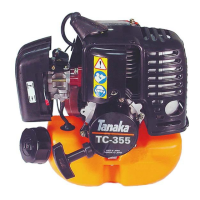www.tanaka-usa.com 15 custsvc@tanaka-ism.com
Service Manual
TC-355
CARBURETOR SERVICE
The main body of the carburetor consists of the carburetor body (A), the
throttle shaft (B) and the throttle wire receiver (C). Two screws secure the
throttle wire receiver and the throttle shaft to the carburetor body. While it’s not
necessary to remove the throttle valve for inspection, rotate it by hand to
ensure that it is able to freely rotate with the carburetor body and that it can
reach the full range of motion permitted between the idle adjustment screw
and the full RPM stopper on the carburetor body. Any binding should be
addressed by blowing forced air into the throttle valve/body area. If it still does
not rotate freely, the entire carburetor will need to be replaced.
Also ensure that the o-ring mounted to the carburetor body on the air cleaner
side is not torn or dried. Replace as necessary. (The o-ring is a component
contained within the carburetor repair kit.)
The fuel tank is mounted to the crankcase with three screws that extend from
underneath the tank, and through the tank-mounting bracket. Additionally,
there are three small spacers that fit within the bolt holes in the fuel tank itself.
Inspect the tank, tank cap, tank vent and fuel lines for any signs of leakage or
damage. Replace as needed.
With the fuel supply line disconnected from the carburetor it is possible to
check the integrity of the fuel filter. With the tank cap securely tightened, gently
shake the tank while partially filled with gasoline. If the filter is allowing gas to
flow, the agitation of the fuel in the tank will force fuel up and out of the fuel
line. If the fuel filter is in question, replace it.
EXHAUST SYSTEM
The exhaust system consists of the muffler / muffler gasket (1),
and heat shield (2).
The muffler is a sealed, non-serviceable unit. If the muffler is
damaged, the entire unit needs to be replaced.
Remove the shroud covering the muffler and cylinder. Remove
the muffler and inspect the exhaust port and mating portion of
muffler for any build of carbon. Carbon build up is a normal
occurrence in a two-cycle engine, and removal is a matter of
routine maintenance.

